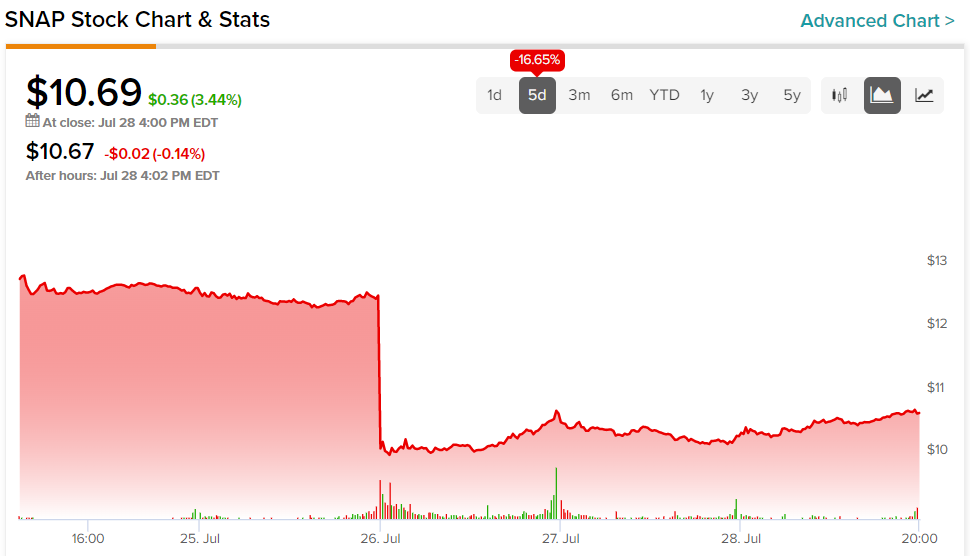Snap Inc. (NASDAQ:SNAP), the holding company of Snapchat, one of the most popular social media platforms in the world, faces an uphill battle to improve its financial performance despite recording strong user growth.
Snap stock crashed 14% after reporting second-quarter earnings as investors looked past the impressive subscriber growth to question the company’s inability to monetize the growing user base. I am neutral on the prospects for Snap, as I believe the company’s monetization struggles will continue in the foreseeable future.

The Monetization Problem Persists
In the second quarter, the number of daily active users of Snapchat increased 14% year-over-year to 397 million. The company reported sequential user growth in each of its major regions, which is a testament to the growing popularity of the social media platform. A granular view of DAU growth reveals that the Rest of World category was the star performer in Q2, adding 12 million daily active users compared to the first quarter.
According to company data, Snapchat now reaches 90% of the 13 to 24-year-old population in over 20 countries, which highlights the platform’s strong popularity among the youth. Snap’s main competitors, such as Instagram and Facebook, have failed to gain traction among young users of late, which is a promising sign for Snap’s future.
In addition to stellar user growth, Snap saw encouraging results from its recent investments in new products. For instance, the number of Snapchatters engaging with artificial reality tools increased to an average of over 250 million in Q2, while the number of publisher partners increased to 900 spread across 20+ countries.
The number of users who interact with Snap Map surpassed 350 million, and the company also reported a 50% year-over-year increase in Place Story views as well. The total time spent watching Spotlight content rose more than 200% in the second quarter compared to the corresponding quarter last year, with 400 million users engaging with Spotlight every month.
Second-quarter user engagement statistics reported by the company leave investors in no doubt that Snap is enjoying record-high levels of user activity. Unfortunately, the company is failing to make use of this from a financial performance perspective.
Despite strong user growth, Snap’s revenue declined 4% year-over-year, but its net loss improved from $422 million a year ago to $377 million. Also, the company reported an adjusted EBITDA loss of $38 million. Average revenue per user (ARPU), which is one of the best indicators of a social media platform’s ability to monetize its users, declined by 16% to $2.69, highlighting the ongoing struggles of the company to generate more revenue from its active users.
Additionally, while the number of ad impressions sold increased by 5%, aided by user growth, the average price per impression declined by a staggering 12%.
Although macroeconomic pressures faced by the advertising industry had an impact on Snap’s lackluster financial performance, most of these issues have persisted for years. One of the biggest problems faced by Snap is attracting high-value brands that spend millions of dollars on advertising campaigns. This is an area Facebook parent Meta Platforms, Inc. (NASDAQ:META) has excelled in.
To attract advertisers, the company is continuing to invest in improving the ad performance measurement tools, but so far, these efforts have not yielded noteworthy results.
Looking ahead, the monetization problem is likely to worsen. With the exponential growth in international Snapchat users, North America now accounts for just 25% of daily active users. Even established social media giants, including Meta, have struggled to monetize active users outside of North America and Europe, and Snap will likely face a similar challenge in the coming years.
With Snapchat users outside of North America and Europe already surpassing the combined number of users in these regions, Snap’s ARPU is likely to take a hit in the coming quarters.
A problem inherent to Snapchat is its primary use as a direct-messaging platform for friends and family, which limits its monetization potential. In comparison, a platform such as Facebook is used to not just connect with friends but also to follow the news, watch videos, buy and sell products, join groups, interact with celebrities, and for a whole lot more use cases. Snapchat is doing its best to create a similar community feel, but the company still has a lot of work to do on this front.
Is Snap a Buy, According to Analysts?
Based on the ratings of 29 Wall Street analysts, the average Snap stock price target is $10.48, which implies 2.4% downside potential. The company also has a Hold consensus rating based on these ratings.

For Snap to attract higher price targets from analysts, the company will have to showcase that its recent investments in improving the experience for advertisers are yielding the desired results. User growth alone is unlikely to force analysts to boost their price targets, as the company does not seem to be well-positioned to convert increasing users into revenue and earnings growth.
Takeaway: Snap Has a Long Road Toward Profitability
Snap is yet to turn profits despite registering stellar revenue and user growth since 2015. The company is at a disadvantage compared to social media giants such as Facebook and Instagram when it comes to attracting high-value advertisers.
The growing proportion of international Snapchat users will make life even more difficult for the company in the foreseeable future, although the growing popularity of the platform in Asia is an encouraging sign from a long-term perspective. The company seems slightly overvalued based on analyst projections, which leaves investors no room for upside.



















